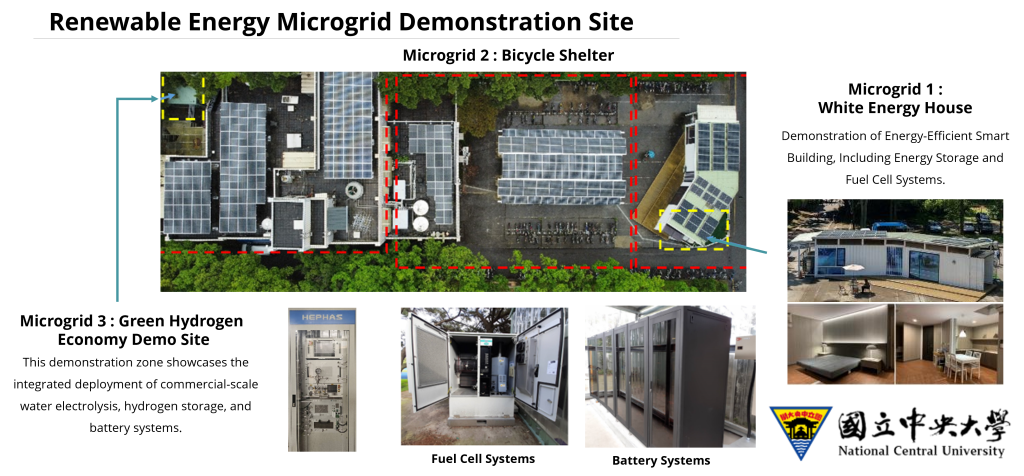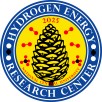Introduction to NCU’s Microgrid & White Energy House
National Central University (NCU) is committed to advancing sustainable energy solutions, and through its Hydrogen Energy Research Center (HERC), NCU has developed a state-of-the-art microgrid demonstration site and the “White Energy House” as living laboratories for renewable energy, energy management, and zero-carbon building technologies.

Microgrid Demonstration at NCU
System Architecture & Motivation
Since 2018, the NCU research team has gradually built up an on-campus microgrid demonstration area to conduct advanced research into power dispatching, energy sharing, and resilient grid operations.
Unlike conventional microgrids that operate either in island mode (disconnected from the grid) or grid-connected mode, NCU’s system goes further by developing networked (interconnected) microgrids. In the event of a grid outage, multiple microgrid units can share power, enhancing resilience and prolonging autonomous operation.
The system integrates:
– Solar photovoltaics (approximately 82 kW)
– A fuel cell system (~20 kW)
– A lithium-ion battery energy storage system (~110 kWh)
– Smart energy management and dispatch control across microgrids
This setup allows the demonstration site to function as a 100 kW class autonomous grid reliant on 100% renewable supply in certain modes.
Key Techniques & Capabilities
Some of the core technologies and control strategies developed and tested in this demonstration include:
1. Power-sharing converter architectures and control algorithms that enable energy exchange among microgrids
2. Internal coordination of renewable generation and load shedding strategies
3. Energy management and operation cost optimization
4. Inter-microgrid power regulation and power quality control
5. Dynamic models and control of fuel cell systems
6. Renewable generation forecasting and demand prediction
7. Smart scheduling of microgrid dispatch in coordination with the main grid
By achieving coordinated control among multiple microgrids and the utility grid, NCU’s demonstration helps pave the way for integrating high penetration of distributed renewable energy into larger power systems while maintaining stability and resilience.
Off-Campus Applications: Rural Microgrids
Beyond on-campus deployment, NCU has extended microgrid applications to rural and disaster-prone regions. For example, in cooperation with Ming Hsin Energy Co., a microgrid system has been deployed at the administrative office of Xiayun Li in Fuxing District as a test site for emergency power supply under disaster scenarios.
This rural microgrid leverages solar + storage + smart management to ensure continuous basic services (lighting, communication, etc.) during outages, fulfilling the goals of “no worry for power,” “self-help in emergencies,” and “tourism support.”
A smaller microgrid is also installed at Yisheng Primary School in the area, powering surveillance, broadcasting, and emergency loads.
Through these real-world deployments, NCU demonstrates the scalability and adaptability of microgrid technologies beyond campus settings.
White Energy House (White Energy Villa) — A Smart Green Building Showcase
Overview & Purpose
The “White Energy House” is located on NCU’s campus (in the Chungli area, on the double-slope near the athletics field), consisting of two refurbished 40-foot shipping containers configured as an 18-ping (≈ 60 m²) smart home prototype. It is designed to emulate a 2-person residence with daily load demand of ~10 kWh, and integrates three core energy domains:
– Generation (創能) via rooftop solar PV
– Storage (儲能) via battery systems
– Energy-saving (節能) through high-performance materials, smart lighting, smart HVAC, and building energy management systems (BEMS)
The White Energy House serves as an educational demonstration site for students, industry partners, local communities, and visitors — showcasing integrated renewable house technologies, controlling, monitoring, and performance evaluation.
Technical Highlights
Some distinctive features and technologies in the White Energy House include:
– Advanced thermal insulation and building envelope materials to reduce heating/cooling loads
– Smart lighting and energy-efficient appliances
– Real-time energy monitoring (generation vs. consumption) via Apps and web interfaces
– Integration with microgrid control and dispatch logic
– Modular design enabling future upgrades (e.g. hydrogen systems)
Since its inauguration, the White Energy House has attracted over 1,500 visitors from more than 50 institutions.
The site is open for guided tours (by appointment; free visits) and serves as a hands-on training ground for students, educators, and the public.
Research & Innovation Synergies
The White Energy House is closely tied to broader energy research objectives at HERC, including hydrogen production, fuel cell integration, and renewable energy system optimization.
For example:
– The team is developing anion exchange membrane water electrolyzers (AEMWE) for efficient hydrogen generation to further enable energy storage and hydrogen integration.
– Researchers are also working on intermediate-temperature solid oxide fuel cell / electrochemical systems, coupling them to renewable systems for high-efficiency conversion.
– The microgrid control algorithms, AI-based scheduling, and energy management tools developed in the campus microgrid are meant to be tested and refined using data gleaned from the White Energy House.
Significance & Impact
– Demonstration & education: The microgrid site and White Energy House serve as real-world platforms for teaching, public outreach, and training future engineers.
– Technology validation: Integration of renewable generation, storage, building systems, and energy control in a live environment allows iterative testing and refinement.
– Resilience & grid support: The networked microgrid architecture enables energy sharing, islanding capability, and resiliency against grid disturbances.
– Scalability & extension: Insights from campus deployment are extended to rural and off-grid communities, enabling disaster response and energy autonomy.
– Research integration: The close coupling with hydrogen, fuel cell, and smart control systems under HERC provides a comprehensive research ecosystem.
– Policy & industry bridging: The demonstration projects function as test beds for industrial products, policy pilots, and public engagement in Taiwan’s journey toward net-zero.
